3000字英文参考文献及其翻译范例
论文外文文献翻译3000字左右
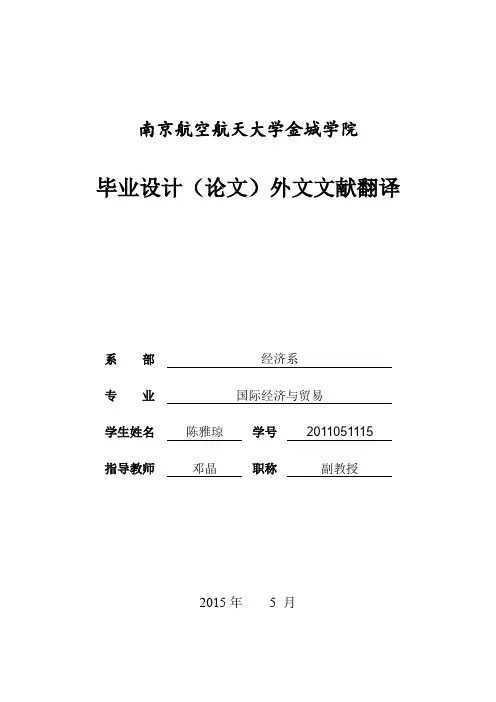
南京航空航天大学金城学院毕业设计(论文)外文文献翻译系部经济系专业国际经济与贸易学生姓名陈雅琼学号2011051115指导教师邓晶职称副教授2015年5月Economic policy,tourism trade and productive diversification(Excerpt)Iza Lejárraga,Peter WalkenhorstThe broad lesson that can be inferred from the analysis is that promoting tourism linkages with the productive capabilities of a host country is a multi-faceted approach influenced by a variety of country conditions.Among these,fixed or semi-fixed factors of production,such as land,labor,or capital,seem to have a relatively minor influence.Within the domain of natural endowments,only agricultural capital emerged as significant.This is a result that corresponds to expectations,given that foods and beverages are the primary source of demand in the tourism economy.Hence,investments in agricultural technology may foment linkages with the tourism market.It is also worth mentioning that for significant backward linkages to emerge with local agriculture,a larger scale of tourism may be important. According to the regression results,a strong tourism–agriculture nexus will not necessarily develop at a small scale of tourism demand.It appears that variables related to the entrepreneurial capital of the host economy are of notable explanatory significance.The human development index(HDI), which is used to measure a country's general level of development,is significantly and positively associated with tourism linkages.One plausible explanation for this is that international tourists,who often originate in high-income countries,may feel more comfortable and thus be inclined to consume more in a host country that has a life-style to which they can relate easily.Moreover,it is important to remember that the HDI also captures the relative achievements of countries in the level of health and education of the population.Therefore,a higher HDI reflects a healthier and more educated workforce,and thus,the quality of local entrepreneurship.Related to this point,it is important to underscore that the level of participation of women in the host economy also has a significantly positive effect on linkages.In sum, enhancing local entrepreneurial capital may expand the linkages between tourism and other sectors of the host country.Formal institutions and their regulatory control of the market,proxied by the size of the government and price controls,were not found to have significant effects on linkages formation.Despite the importance of democratic governance,this was not identified as a key determinant either.On the other hand,the significance of informal institutions accords with the clustering dynamics inherent in tourism,in which linkages are formed on the basis of self-enforcing“relations-based”governance.Also,informal structures cost less than formal,rules-driven institutional frameworks for entrepreneurship.Therefore,highly formalized regulations can deter the spontaneous and cost-driven coordination among potential local suppliers and the potential buyers of the tourism economy.One type of formal institutions that does matter is policing and vigilance.As would be expected,the results show that countries with higher incidence of violence or crime are significantly associated with lower levels of tourism linkages.Indeed, the coordination of providers in tourism clusters depends fundamentally on trust among local entrepreneurs and trust can hardly flourish in an environment characterized by social conflict.Equally important,the perception of violence on the part of tourists and hotels will dissuade tourists from venturing beyond the safe boundaries of the“enclave”hotel resort.Finally,hotel managers and other foreign investors in the tourism economy will be less inclined to maintain productive relations with the host economy in the absence of predictability and stability. Therefore,investments in institutions that maintain safety and a perception of safety,in the host economy appear critical for spawning coordination.While all country domains may be playing a role in fostering or hindering linkages, the business environment seems to exert an overriding influence on linkages.After controlling for a country's natural endowments,level of development,and institutional maturity,the business environment on its own explains almost20%of cross-country variations in linkages.In particular,the level of corporate taxes in the host economy is associated with the most significant adverse effect on the formation of linkages,in conformity with the lower-cost motivation underlying tourism-led linkage creation.Also,a widespread usage of internet is alsosignificantly associated with a positive effect in the ability of suppliers to orchestrate coordination in tourism linkages.Moreover,the results suggest that there could be a role for government in improving trade facilitation and reducing transportation costs.Also,maintaining an open trade regime seems to be critical for the emergence of linkages.This underscores the importance of not protecting inefficient economic activities and opening potential products for tourism demand to competition.Although trade barriers may indeed serve to prod investors in the tourism economy to procure domestic goods, they will also hinder the competitiveness of local producers.Shielded from imports, local producers will not have the incentives to meet the international quality standards of the products needed by the tourism economy.Yet,quality expectations, possibly more so than costs,will likely inform the procurement decisions of the tourism economy.Concerning the relative magnitude of the effects of the different domains on linkages,the business environment and trade regulations stand out.The independent contributions of these domains,that is their ability to explain variations in the dependent variable when no controls for other domains are applied,amount to53%and 43%,respectively.The level-of-development domain follows with25%explanatory power,while the domains covering institutions and endowments provide an independent contribution of23%each.The implications of the analysis should be considered in light of its limitations. Causal direction cannot be fully substantiated,because we use a cross-sectional approach due to data limitations.In the absence of time-series for the variables at hand,it is not possible to test for causation.While the explanatory variables concerning natural endowments are exogenous,some of the other explanatory variables could potentially be subject to reverse causality.That said,there do not seem to be a priori strong conceptual reasons that would lead us to believe that the degree of tourism linkages critically affects trade policy,the quality of institutions, and other variables of our model.Moreover,the risk of encountering problems of reverse causality is mitigated by the observation that several longitudinal studies have established a causal relationship that runs from higher levels of economic development Eugenio-Martin et al.(2008)or a better business environment(Barrowclough,2007and Selvanathan et al.,2009)to the development of the tourism sector,rather than the other way around.Finally,the construction of the dependent variable as a ratio of indirect to direct tourism expenditure makes the reverse causality hypothesis less compelling. While it might be expected that an expansion of the tourism sector that increases total revenues and employment opportunities might have an impact on the explanatory variables,it is less evident that a change in the composition of tourism revenues, as implied by a change in the LINK variable,would have such an effect.That said, the confidence in our findings would clearly be further enhanced,if supported by results from future studies based on longitudinal designs.The scientific environmental ethics plays a key role in the recognition of the human—environment interactions.Modern environmental ethics is the philosophical rethinking of modern human race environmental behavior.The development of environmental ethics theory as well as its application in reality.determines the viewpoints of environmental ethics.Sustainable development implies harmony on human-environment interactions and intergeneration responsibility,with emphasis on a harmonious relationship among population,resources,environment and development,so as to lay a sustainable and healthy foundation of resources and environment for future generations.The harmonious society construction in China that is raised by the Chinese central government should be covered by environmental ethics.The connotation of open environmental ethics includes a respect for nature.care for the individual human race.and respect for the development of future generations,which means giving consideration to natural values.individual and human race benefits and welfare across generations.The role of environmental ethics in regional development consists of cognition,criticism,education,inspiration,adjusting,legislation and promoting environmental regulations.The major problems in regional development are extensive resource exploration,fast population growth irrational,industrialstructure.Unfair welfare distribution and the twofold effects of science and technology development.The formulation of environmental ethics that aims at regional sustainable development,can not only harmonize the relationship of population,resource,environment and economic development,but also guide behavior selection,push social and political system transformation.strengthen the legal system,and raise environmental awareness of the public.Human races face severe global challenges in resources,environment,population and poverty.To solve these problems science and technology should be developed on one hand,and human-environment interactions should be adjusted on the other hand.Modem environmental ethics is the philosophical review on modem human race environmental behavior.Environmental ethics can be a view point as the moral perception of the relationship between humankind and nature in general.The keystone of sustainable development is on harmonious human.environment interactions.with an emphasis on sustainable environmental ethics.Environmental ethics and sustainable development are key issues in the study of man.1and system,as well as a precondition to regional development(Zheng,2005a).Though there exists theoretical divergence in different environmental ideologies.some general understandings can also be obtained:human races are the only ethical agents on earth;the essence of the environmental crisis is a cultural and value crisis;future generations have the same right as current generations,especially on survival space;differences should be made between human race and other entities on earth,at the same time they are an undivided union;the capability of the earth is limited.Based on the above general understandings.it is possible to form a more open and sustainable environmental ethics.A more open and sustainable environmental ethics has some special connections.To respect and treat nature friendly means to acknowledge the value and right of nature,that is to say,minimum hurt criterion,basic benefit criterion and fair compensation criterion should be followed.To pay attention to both individuals and mankind should follow justice criterion,equity criterion and cooperation criterion.To have futuregeneration in mind Should follow responsibility criterion,saving criterion,and cautiousness criterion(Wang,2003;Wang,2004a).The conclusion to be drawn from the above is to give attention to both human race and natural value.to both individual and mankind’s benefit。
毕业论文英文参考文献与译文
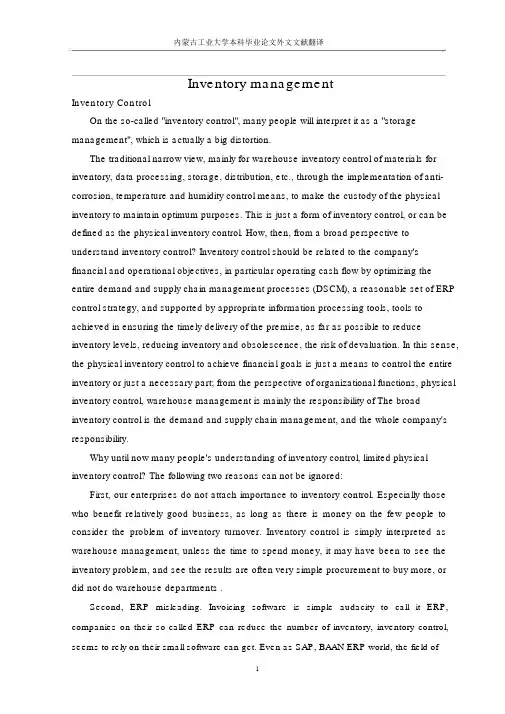
Inventory managementInventory ControlOn the so-called "inventory control", many people will interpret it as a "storage management", which is actually a big distortion.The traditional narrow view, mainly for warehouse inventory control of materials for inventory, data processing, storage, distribution, etc., through the implementation of anti-corrosion, temperature and humidity control means, to make the custody of the physical inventory to maintain optimum purposes. This is just a form of inventory control, or can be defined as the physical inventory control. How, then, from a broad perspective to understand inventory control? Inventory control should be related to the company's financial and operational objectives, in particular operating cash flow by optimizing the entire demand and supply chain management processes (DSCM), a reasonable set of ERP control strategy, and supported by appropriate information processing tools, tools to achieved in ensuring the timely delivery of the premise, as far as possible to reduce inventory levels, reducing inventory and obsolescence, the risk of devaluation. In this sense, the physical inventory control to achieve financial goals is just a means to control the entire inventory or just a necessary part; from the perspective of organizational functions, physical inventory control, warehouse management is mainly the responsibility of The broad inventory control is the demand and supply chain management, and the whole company's responsibility.Why until now many people's understanding of inventory control, limited physical inventory control? The following two reasons can not be ignored:First, our enterprises do not attach importance to inventory control. Especially those who benefit relatively good business, as long as there is money on the few people to consider the problem of inventory turnover. Inventory control is simply interpreted as warehouse management, unless the time to spend money, it may have been to see the inventory problem, and see the results are often very simple procurement to buy more, or did not do warehouse departments .Second, ERP misleading. Invoicing software is simple audacity to call it ERP, companies on their so-called ERP can reduce the number of inventory, inventory control, seems to rely on their small software can get. Even as SAP, BAAN ERP world, the field ofthese big boys, but also their simple modules inside the warehouse management functionality is defined as "inventory management" or "inventory control." This makes the already not quite understand what our inventory control, but not sure what is inventory control.In fact, from the perspective of broadly understood, inventory control, shouldinclude the following:First, the fundamental purpose of inventory control. We know that the so-called world-class manufacturing, two key assessment indicators (KPI) is, customer satisfaction and inventory turns, inventory turns and this is actually the fundamental objective of inventory control.Second, inventory control means. Increase inventory turns, relying solely on the so-called physical inventory control is not enough, it should be the demand and supply chain management process flow of this large output, and this big warehouse management processes in addition to including this link, the more important The section also includes: forecasting and order processing, production planning and control, materials planning and purchasing control, inventory planning and forecasting in itself, as well as finished products, raw materials, distribution and delivery of the strategy, and even customs management processes.And with the demand and supply chain management processes throughout the process, it is the information flow and capital flow management. In other words, inventory itself is across the entire demand and supply management processes in all aspects of inventory control in order to achieve the fundamental purpose, it must control all aspects of inventory, rather than just manage the physical inventory at hand.Third, inventory control, organizational structure and assessment.Since inventory control is the demand and supply chain management processes, output, inventory control to achieve the fundamental purpose of this process must be compatible with a rational organizational structure. Until now, we can see that many companies have only one purchasing department, purchasing department following pipe warehouse. This is far short of inventory control requirements. From the demand and supply chain management process analysis, we know that purchasing and warehouse management is the executive arm of the typical, and inventory control should focus on prevention, the executive branch is very difficult to "prevent inventory" for the simple reason that they assessment indicatorsin large part to ensure supply (production, customer). How the actual situation, a reasonable demand and supply chain management processes, and thus set the corresponding rational organizational structure and is a question many of our enterprisesto exploreThe role of inventory controlInventory management is an important part of business management. In the production and operation activities, inventory management must ensure that both the production plant for raw materials, spare parts demand, but also directly affect the purchasing, sales of share, sales activities. To make an inventory of corporate liquidity, accelerate cash flow, the security of supply under the premise of minimizing Yaku funds, directly affects the operational efficiency. Ensure the production and operation needs of the premise, so keep inventories at a reasonable level; dynamic inventory control, timely, appropriate proposed order to avoid over storage or out of stock; reduce inventory footprint, lower total cost of inventory; control stock funds used to accelerate cash flow.Problems arising from excessive inventory: increased warehouse space andinventory storage costs, thereby increasing product costs; take a lot of liquidity, resultingin sluggish capital, not only increased the burden of payment of interest, etc., would affect the time value of money and opportunity income; finished products and raw materials caused by physical loss and intangible losses; a large number of enterprise resource idle, affecting their rational allocation and optimization; cover the production, operation of the whole process of the various contradictions and problems, is not conducive to improve the management level.Inventory is too small the resulting problems: service levels caused a decline in the profit impact of marketing and corporate reputation; production system caused by inadequate supply of raw materials or other materials, affecting the normal production process; to shorten lead times, increase the number of orders, so order (production) costs; affect the balance of production and assembly of complete sets.NotesInventory management should particularly consider the following two questions:First, according to sales plans, according to the planned production of the goods circulated in the market, we should consider where, how much storage.Second, starting from the level of service and economic benefits to determine howto ensure inventories and supplementary questions.The two problems with the inventory in the logistics process functions.In general, the inventory function:(1)to prevent interrupted. Received orders to shorten the delivery of goods fromthe time in order to ensure quality service, at the same time to prevent out of stock.(2)to ensure proper inventory levels, saving inventory costs.(3)to reduce logistics costs. Supplement with the appropriate time interval compatible with the reasonable demand of the cargo in order to reduce logistics costs, eliminate or avoid sales fluctuations.(4)ensure the production planning, smooth to eliminate or avoid sales fluctuations.(5)display function.(6)reserve. Mass storage when the price falls, reduce losses, to respond to disasters and other contingencies.About the warehouse (inventory) on what the question, we must consider the number and location. If the distribution center, it should be possible according to customer needs, set at an appropriate place; if it is stored in central places to minimize the complementary principle to the distribution centers, there is no place certain requirements. When the stock base is established, will have to take into account are stored in various locations in what commodities.库存管理库存控制在谈到所谓“库存控制”的时候,很多人将其理解为“仓储管理”,这实际上是个很大的曲解。
外文参考文献译文及原文【范本模板】
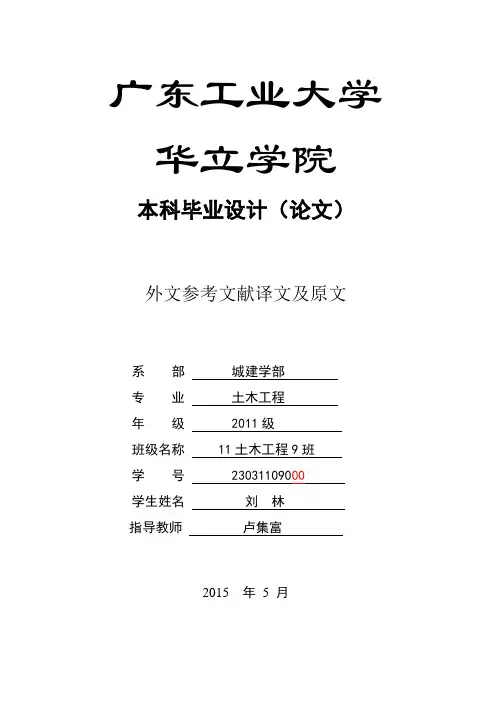
广东工业大学华立学院本科毕业设计(论文)外文参考文献译文及原文系部城建学部专业土木工程年级 2011级班级名称 11土木工程9班学号 23031109000学生姓名刘林指导教师卢集富2015 年5 月目录一、项目成本管理与控制 0二、Project Budget Monitor and Control (1)三、施工阶段承包商在控制施工成本方面所扮演的作用 (2)四、The Contractor’s Role in Building Cost Reduction After Design (4)一、外文文献译文(1)项目成本管理与控制随着市场竞争的激烈性越来越大,在每一个项目中,进行成本控制越发重要。
本文论述了在施工阶段,项目经理如何成功地控制项目预算成本。
本文讨论了很多方法。
它表明,要取得成功,项目经理必须关注这些成功的方法.1。
简介调查显示,大多数项目会碰到超出预算的问……功控制预算成本.2.项目控制和监测的概念和目的Erel and Raz (2000)指出项目控制周期包括测量成……原因以及决定纠偏措施并采取行动。
监控的目的就是纠偏措施的。
.。
标范围内。
3.建立一个有效的控制体系为了实现预算成本的目标,项目管理者需要建立一……被监测和控制是非常有帮助的。
项目成功与良好的沟通密。
决( Diallo and Thuillier, 2005).4.成本费用的检测和控制4.1对检测的优先顺序进行排序在施工阶段,很多施工活动是基于原来的计……用完了。
第四,项目管理者应该检测高风险活动,高风险活动最有。
..重要(Cotterell and Hughes, 1995)。
4.2成本控制的方法一个项目的主要费用包括员工成本、材料成本以及工期延误的成本。
为了控制这些成本费用,项目管理者首先应该建立一个成本控制系统:a)为财务数据的管理和分析工作落实责任人员b)确保按照项目的结构来合理分配所有的……它的变化-—在成本控制线上准确地记录所有恰..。
3000字外文文献翻译
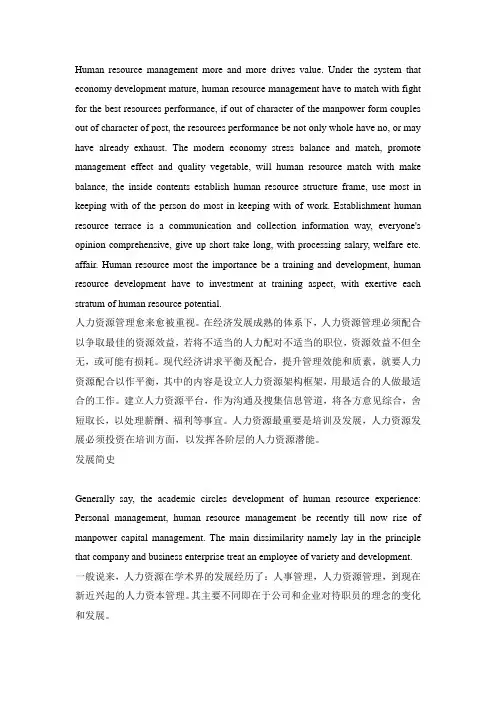
Human resource management more and more drives value. Under the system that economy development mature, human resource management have to match with fight for the best resources performance, if out of character of the manpower form couples out of character of post, the resources performance be not only whole have no, or may have already exhaust. The modern economy stress balance and match, promote management effect and quality vegetable, will human resource match with make balance, the inside contents establish human resource structure frame, use most in keeping with of the person do most in keeping with of work. Establishment human resource terrace is a communication and collection information way, everyone's opinion comprehensive, give up short take long, with processing salary, welfare etc. affair. Human resource most the importance be a training and development, human resource development have to investment at training aspect, with exertive each stratum of human resource potential.人力资源管理愈来愈被重视。
外文参考文献译文及原文
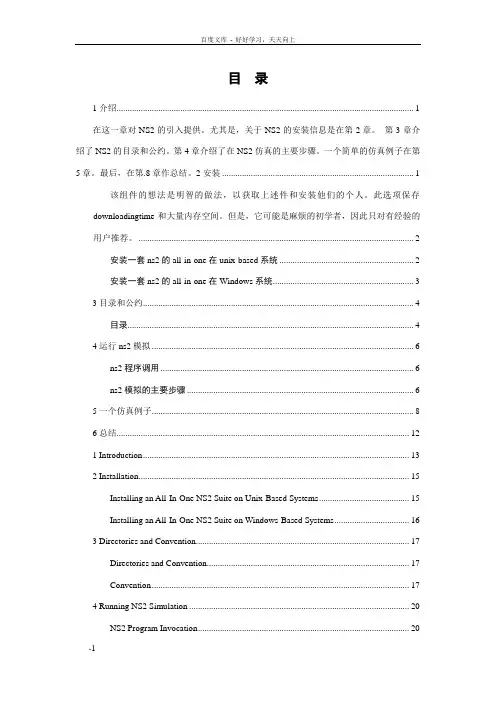
目录1介绍 (1)在这一章对NS2的引入提供。
尤其是,关于NS2的安装信息是在第2章。
第3章介绍了NS2的目录和公约。
第4章介绍了在NS2仿真的主要步骤。
一个简单的仿真例子在第5章。
最后,在第.8章作总结。
2安装 (1)该组件的想法是明智的做法,以获取上述件和安装他们的个人。
此选项保存downloadingtime和大量内存空间。
但是,它可能是麻烦的初学者,因此只对有经验的用户推荐。
(2)安装一套ns2的all-in-one在unix-based系统 (2)安装一套ns2的all-in-one在Windows系统 (3)3目录和公约 (4)目录 (4)4运行ns2模拟 (6)ns2程序调用 (6)ns2模拟的主要步骤 (6)5一个仿真例子 (8)6总结 (12)1 Introduction (13)2 Installation (15)Installing an All-In-One NS2 Suite on Unix-Based Systems (15)Installing an All-In-One NS2 Suite on Windows-Based Systems (16)3 Directories and Convention (17)Directories and Convention (17)Convention (17)4 Running NS2 Simulation (20)NS2 Program Invocation (20)Main NS2 Simulation Steps (20)5 A Simulation Example (22)6 Summary (27)1介绍网络模拟器(一般叫作NS2)的版本,是证明了有用在学习通讯网络的动态本质的一个事件驱动的模仿工具。
模仿架线并且无线网络作用和协议(即寻址算法,TCP,UDP)使用NS2,可以完成。
一般来说,NS2提供用户以指定这样网络协议和模仿他们对应的行为方式。
外文文献翻译原文及译文
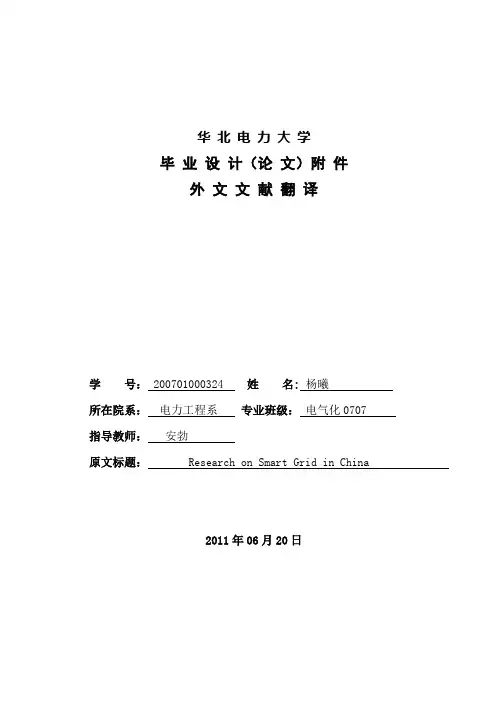
华北电力大学毕业设计(论文)附件外文文献翻译学号: 200701000324 姓名:杨曦所在院系:电力工程系专业班级:电气化0707指导教师:安勃原文标题: Research on Smart Grid in China2011年06月20日对中国智能电网的研究1摘要——智能电网是电力系统的未来发展的新方向。
在本文中,首先是智能电网的背景,意义,以及概念和结构。
典型的智能电网图如下所示.然后,在美国和欧洲智能电网的发展现状进行了描述,并对这些国家未来发展思路的趋势进行了总结和比较及分析。
此外,分析了中国智能电网发展的必要性,详细介绍了在目前与中国与有关项目,并对特高压电网和智能电网之间的的关系进行了讨论。
最后,对智能电网在未来在中国电网的潜在作用进行了展望和并为中国的智能电网发展指明新方向.索引词,智能电网,特高压电网,规划,经营,管理一导言随着世界经济全球化的推广,石油价格一直维持在一个上升的趋势。
还值得注意的是世界范围内的的能源供应短缺,对资源和环境的压力越来越大,同时,由于目前电网的低效率,在能源输送过程中损失了巨大的电力。
此外,由于不断增长的电力需求和用户对电力可靠性和质量日益增长的要求,电力工业正面临着前所未有的挑战和机遇。
因此,一个有环境友好,经济,高性能,低投资,安全性,可靠性和灵活性特点的的电力系统一直是电力工程师的目标。
尽管如此,基础设施和先进的仪表出现互联网更广泛地的使用加速了这个过程[1]。
自1990年以来随着分布式发电越来越多地使用,已经对对电网的强度提出更多的需求和要求[2][3]。
对于这些问题,为了找出最佳的解决方案,电力公司应接受新的思路,采用新技术,对现有的能源系统进行潜力挖掘,对技术和应用加以改进。
来自不同国家的学者和专家已经达成共识:未来电网的必须能够满足不同的需求及能源发电,高度市场化的电力交易的需求,由此可以满足客户的自我选择。
所有这些都将成为未来智能电网的发展方向。
3000字译文范本
毕业论文附件:英译汉(译文)题目:持续的决策导向型规划原作:[美] 迈克尔·曼金斯(Michael C, Mankins)理查德·斯蒂尔(Richard Steele)2004级工商管理2班胡蓉芳译译文:迈克尔·曼金斯(mmankins@)战略与管理咨询机构Marakon Associates旧金山分公司的执行合伙人,他还是The Value Imperative Managing for Superior Shareholder Returns(自由出版社,1994)一书的作者之一;理查德·斯蒂尔(rsteele@) Marakon Associates纽约分公司的合伙人。
持续的决策导向型规划当公司作为一个统一的整体确定了最重要的战略优先事项后(一般会通过年度战略规划进行),就会在整年时间内连续开展执行委员会对话、以求在尽可能多的问题上做出决策,因为许多问题都会涉及多个业务单元,所以公司成立了一些特别工作小组,专门负责准备决策所需的战略和财务信息,以找出每个问题的战略备选方案并进行评估,准备信息的时间可能超过9个星期。
波音民用飞机集团(Boeing Commercial Airplanes, BCA)就是这方面的一个例子。
作为波音公司最大的一个业务集团,BCA多年来一直采用的是长期业务规划流程,这是因为民用飞机的制造周期漫长,因此该集团的CEO艾伦•穆拉利(Alan Mulally)及其领导团队必须从长期角度考虑生产及经营问题,BCA的长期经营方案包含一个十年财务预算,其中具体包括预计收入,未能交付的积压订货量,应允毛利,以及资本投资,BCA的领导团队每周对经营方案进行审核,以便跟踪本集团的实际业绩相比计划业绩的情况,同时保持集团内成员对执行的关注。
随后,执行委员会将与每个业务单元举行另一轮会议,就业绩目标,资源投入,以及(在许多情况下)管理人员的报酬问题进行协商。
外文参考文献译文及原文
广东工业大学华立学院本科毕业设计(论文)外文参考文献译文及原文系部城建学部专业土木工程年级 2011级班级名称 11土木工程9班学号 23031109000学生姓名刘林指导教师卢集富2015 年5 月目录一、项目成本管理与控制 0二、Project Budget Monitor and Control (1)三、施工阶段承包商在控制施工成本方面所扮演的作用 (2)四、The Contractor's Role in Building Cost Reduction After Design (4)一、外文文献译文(1)项目成本管理与控制随着市场竞争的激烈性越来越大,在每一个项目中,进行成本控制越发重要。
本文论述了在施工阶段,项目经理如何成功地控制项目预算成本。
本文讨论了很多方法。
它表明,要取得成功,项目经理必须关注这些成功的方法。
1.简介调查显示,大多数项目会碰到超出预算的问……功控制预算成本。
2.项目控制和监测的概念和目的Erel and Raz (2000)指出项目控制周期包括测量成……原因以及决定纠偏措施并采取行动。
监控的目的就是纠偏措施的...标范围内。
3.建立一个有效的控制体系为了实现预算成本的目标,项目管理者需要建立一……被监测和控制是非常有帮助的。
项目成功与良好的沟通密...决( Diallo and Thuillier, 2005)。
4.成本费用的检测和控制4.1对检测的优先顺序进行排序在施工阶段,很多施工活动是基于原来的计……用完了。
第四,项目管理者应该检测高风险活动,高风险活动最有...重要(Cotterell and Hughes, 1995)。
4.2成本控制的方法一个项目的主要费用包括员工成本、材料成本以及工期延误的成本。
为了控制这些成本费用,项目管理者首先应该建立一个成本控制系统:a)为财务数据的管理和分析工作落实责任人员b)确保按照项目的结构来合理分配所有的……它的变化--在成本控制线上准确地记录所有恰...围、变更、进度、质量)相结合由于一个工程项目......虑时间价值影响后的结果。
外文参考文献(带中文翻译)
外文资料原文涂敏之会计学 8051208076Title:Future of SME finance(c)Background – the environment for SME finance has changedFuture economic recovery will depend on the possibility of Crafts, Trades and SMEs to exploit their potential for growth and employment creation.SMEs make a major contribution to growth and employment in the EU and are at the heart of the Lisbon Strategy, whose main objective is to turn Europe into the most competitive and dynamic knowledge-based economy in the world. However, the ability of SMEs to grow depends highly on their potential to invest in restructuring, innovation and qualification. All of these investments need capital and therefore access to finance.Against this background the consistently repeated complaint of SMEs about their problems regarding access to finance is a highly relevant constraint that endangers the economic recovery of Europe.Changes in the finance sector influence the behavior of credit institutes towards Crafts, Trades and SMEs. Recent and ongoing developments in the banking sector add to the concerns of SMEs and will further endanger their access to finance. The main changes in the banking sector which influence SME finance are:•Globalization and internationalization have increased the competition and the profit orientation in the sector;•worsening of the economic situations in some institutes (burst of the ITC bubble, insolvencies) strengthen the focus on profitability further;•Mergers and restructuring created larger structures and many local branches, which had direct and personalized contacts with small enterprises, were closed;•up-coming implementation of new capital adequacy rules (Basel II) will also change SME business of the credit sector and will increase its administrative costs;•Stricter interpretation of State-Aide Rules by the European Commission eliminates the support of banks by public guarantees; many of the effected banks are very active in SME finance.All these changes result in a higher sensitivity for risks and profits in the financesector.The changes in the finance sector affect the accessibility of SMEs to finance.Higher risk awareness in the credit sector, a stronger focus on profitability and the ongoing restructuring in the finance sector change the framework for SME finance and influence the accessibility of SMEs to finance. The most important changes are: •In order to make the higher risk awareness operational, the credit sector introduces new rating systems and instruments for credit scoring;•Risk assessment of SMEs by banks will force the enterprises to present more and better quality information on their businesses;•Banks will try to pass through their additional costs for implementing and running the new capital regulations (Basel II) to their business clients;•due to the increase of competition on interest rates, the bank sector demands more and higher fees for its services (administration of accounts, payments systems, etc.), which are not only additional costs for SMEs but also limit their liquidity;•Small enterprises will lose their personal relationship with decision-makers in local branches –the credit application process will become more formal and anonymous and will probably lose longer;•the credit sector will lose more and more i ts “public function” to provide access to finance for a wide range of economic actors, which it has in a number of countries, in order to support and facilitate economic growth; the profitability of lending becomes the main focus of private credit institutions.All of these developments will make access to finance for SMEs even more difficult and / or will increase the cost of external finance. Business start-ups and SMEs, which want to enter new markets, may especially suffer from shortages regarding finance. A European Code of Conduct between Banks and SMEs would have allowed at least more transparency in the relations between Banks and SMEs and UEAPME regrets that the bank sector was not able to agree on such a commitment.Towards an encompassing policy approach to improve the access of Crafts, Trades and SMEs to financeAll analyses show that credits and loans will stay the main source of finance for the SME sector in Europe. Access to finance was always a main concern for SMEs, but the recent developments in the finance sector worsen the situation even more.Shortage of finance is already a relevant factor, which hinders economic recovery in Europe. Many SMEs are not able to finance their needs for investment.Therefore, UEAPME expects the new European Commission and the new European Parliament to strengthen their efforts to improve the framework conditions for SME finance. Europe’s Crafts, Trades and SMEs ask for an encompassing policy approach, which includes not only the conditions for SMEs’ access to l ending, but will also strengthen their capacity for internal finance and their access to external risk capital.From UEAPME’s point of view such an encompassing approach should be based on three guiding principles:•Risk-sharing between private investors, financial institutes, SMEs and public sector;•Increase of transparency of SMEs towards their external investors and lenders;•improving the regulatory environment for SME finance.Based on these principles and against the background of the changing environment for SME finance, UEAPME proposes policy measures in the following areas:1. New Capital Requirement Directive: SME friendly implementation of Basel IIDue to intensive lobbying activities, UEAPME, together with other Business Associations in Europe, has achieved some improvements in favour of SMEs regarding the new Basel Agreement on regulatory capital (Basel II). The final agreement from the Basel Committee contains a much more realistic approach toward the real risk situation of SME lending for the finance market and will allow the necessary room for adaptations, which respect the different regional traditions and institutional structures.However, the new regulatory system will influence the relations between Banks and SMEs and it will depend very much on the way it will be implemented into European law, whether Basel II becomes burdensome for SMEs and if it will reduce access to finance for them.The new Capital Accord form the Basel Committee gives the financial market authorities and herewith the European Institutions, a lot of flexibility. In about 70 areas they have room to adapt the Accord to their specific needs when implementing itinto EU law. Some of them will have important effects on the costs and the accessibility of finance for SMEs.UEAPME expects therefore from the new European Commission and the new European Parliament:•The implementation of the new Capital Requirement Directive will be costly for the Finance Sector (up to 30 Billion Euro till 2006) and its clients will have to pay for it. Therefore, the implementation – especially for smaller banks, which are often very active in SME finance –has to be carried out with as little administrative burdensome as possible (reporting obligations, statistics, etc.).•The European Regulators must recognize traditional instruments for collaterals (guarantees, etc.) as far as possible.•The European Commission and later the Member States should take over the recommendations from the European Parliament with regard to granularity, access to retail portfolio, maturity, partial use, adaptation of thresholds, etc., which will ease the burden on SME finance.2. SMEs need transparent rating proceduresDue to higher risk awareness of the finance sector and the needs of Basel II, many SMEs will be confronted for the first time with internal rating procedures or credit scoring systems by their banks. The bank will require more and better quality information from their clients and will assess them in a new way. Both up-coming developments are already causing increasing uncertainty amongst SMEs.In order to reduce this uncertainty and to allow SMEs to understand the principles of the new risk assessment, UEAPME demands transparent rating procedures –rating procedures may not become a “Black Box” for SMEs: •The bank should communicate the relevant criteria affecting the rating of SMEs.•The bank should inform SMEs about its assessment in order to allow SMEs to improve.The negotiations on a European Code of Conduct between Banks and SMEs , which would have included a self-commitment for transparent rating procedures by Banks, failed. Therefore, UEAPME expects from the new European Commission and the new European Parliament support for:•binding rules in the framework of the new Capital Adequacy Directive,which ensure the transparency of rating procedures and credit scoring systems for SMEs;•Elaboration of national Codes of Conduct in order to improve the relations between Banks and SMEs and to support the adaptation of SMEs to the new financial environment.3. SMEs need an extension of credit guarantee systems with a special focus on Micro-LendingBusiness start-ups, the transfer of businesses and innovative fast growth SMEs also depended in the past very often on public support to get access to finance. Increasing risk awareness by banks and the stricter interpretation of State Aid Rules will further increase the need for public support.Already now, there are credit guarantee schemes in many countries on the limit of their capacity and too many investment projects cannot be realized by SMEs.Experiences show that Public money, spent for supporting credit guarantees systems, is a very efficient instrument and has a much higher multiplying effect than other instruments. One Euro form the European Investment Funds can stimulate 30 Euro investments in SMEs (for venture capital funds the relation is only 1:2).Therefore, UEAPME expects the new European Commission and the new European Parliament to support:•The extension of funds for national credit guarantees schemes in the framework of the new Multi-Annual Programmed for Enterprises;•The development of new instruments for securitizations of SME portfolios;•The recognition of existing and well functioning credit guarantees schemes as collateral;•More flexibility within the European Instruments, because of national differences in the situation of SME finance;•The development of credit guarantees schemes in the new Member States;•The development of an SBIC-like scheme in the Member States to close the equity gap (0.2 – 2.5 Mio Euro, according to the expert meeting on PACE on April 27 in Luxemburg).•the development of a financial support scheme to encourage the internalizations of SMEs (currently there is no scheme available at EU level: termination of JOP, fading out of JEV).4. SMEs need company and income taxation systems, whichstrengthen their capacity for self-financingMany EU Member States have company and income taxation systems with negative incentives to build-up capital within the company by re-investing their profits. This is especially true for companies, which have to pay income taxes. Already in the past tax-regimes was one of the reasons for the higher dependence of Europe’s SMEs on bank lending. In future, the result of rating w ill also depend on the amount of capital in the company; the high dependence on lending will influence the access to lending. This is a vicious cycle, which has to be broken.Even though company and income taxation falls under the competence of Member States, UEAPME asks the new European Commission and the new European Parliament to publicly support tax-reforms, which will strengthen the capacity of Crafts, Trades and SME for self-financing. Thereby, a special focus on non-corporate companies is needed.5. Risk Capital – equity financingExternal equity financing does not have a real tradition in the SME sector. On the one hand, small enterprises and family business in general have traditionally not been very open towards external equity financing and are not used to informing transparently about their business.On the other hand, many investors of venture capital and similar forms of equity finance are very reluctant regarding investing their funds in smaller companies, which is more costly than investing bigger amounts in larger companies. Furthermore it is much more difficult to set out of such investments in smaller companies.Even though equity financing will never become the main source of financing for SMEs, it is an important instrument for highly innovative start-ups and fast growing companies and it has therefore to be further developed. UEAPME sees three pillars for such an approach where policy support is needed:Availability of venture capital•The Member States should review their taxation systems in order to create incentives to invest private money in all forms of venture capital.•Guarantee instruments for equity financing should be further developed.Improve the conditions for investing venture capital into SMEs•The development of secondary markets for venture capital investments in SMEs should be supported.•Accounting Standards for SMEs should be revised in order to easetransparent exchange of information between investor and owner-manager.Owner-managers must become more aware about the need for transparency towards investors•SME owners will have to realise that in future access to external finance (venture capital or lending) will depend much more on a transparent and open exchange of information about the situation and the perspectives of their companies.•In order to fulfil the new needs for transparency, SMEs will have to use new information instruments (business plans, financial reporting, etc.) and new management instruments (risk-management, financial management, etc.).外文资料翻译涂敏之会计学 8051208076题目:未来的中小企业融资背景:中小企业融资已经改变未来的经济复苏将取决于能否工艺品,贸易和中小企业利用其潜在的增长和创造就业。
3000字英文论文
3000字英文论文篇一:英语3000字论文From mid-2022 to the present, many large international Clothing Buyers to shift their business out of Sri Lanka, into more cheap manufacturing destination. During this time, in seven provinces to close 75 factories, including 24 factories in the past 6 months to close. The survey was conducted in February 2022, is a private advisory body RoyDawson conducted.The survey found that many of the major Sri Lankan Clothing Foreign buyers in the past three years, closed their offices in Sri Lanka, their manufacturing orders to other countries.Procurement office in Sri Lanka Apparel Association registered about 50 major international apparel sourcing units, 12 units in the past three years, closed their offices in Sri Lanka. The major shift procurement office in Singapore, India and Pakistan. Production mainly to India, Bangladesh and Vietnam.So far, about 20 foreign buyers no longer a stable operation in Sri Lanka.A major reason for their transfer business in Sri Lankas production costs are relatively high and unstable security situation is also a Print . For example, buyers find it difficult to dispatch technical personnel to local factories for regular factory monitoring, which is at the security concerns.The survey also found that the seven provinces in the investigation of the 75 garment factories in mid-2022 and 2022, only in the past 6 months, there are 24 factories closed. These factories are mainly located in Katunayake, Biyagama, Koggala and SeethawakaPura the free trade zone. Some factoriesregistered in the Investment Authority, part of the plant in the Ministry of Industrial Development Textile Office. In addition, these garment factories closed due to foreign exchange losses to combat unemployment and other related industries. This includes embroidery factory, garments washing plants, manufacturing plants fold, label manufacturing plant, silk manufacturing units Plastic Rack and the polyethylene bag manufacturing units, transport service providers, shipping agency, freight Proxy Agencies, customs clearing technological transformation, Food Providers, sub-contractors to provide services, such as fabric cutting, ironing and packing.The survey showed that in 1980 and 2022, in Sri Lanka has 650 large, medium and small-scale garment manufacturing plant, to increase the direct employment of 45 million people, 10 million people with indirectemployment. However, since 2022, the termination ofmulti-fiber agreement and the end of export quotas, Sri Lankas garment industry stable contraction.This is mainly due to Sri Lankas apparel manufacturing with other Asian countries compared to the higher cost of production. The current global recession has also hit the apparel industry in the past 6 months, increase the frequency of plant closures. After reading this article,people also read:? ? ? ?? Jul 29.2022 transition InspirationJul 29.2022 Jul 29.2022 Jul 29.2022 Jul 29.2022篇二:快易准英语论文3000字一项攻克世界难题的发明成果──快易准英语不用国际音标准确朗读英文是世界难题,我发明的快易准英语攻克了这个难题。
- 1、下载文档前请自行甄别文档内容的完整性,平台不提供额外的编辑、内容补充、找答案等附加服务。
- 2、"仅部分预览"的文档,不可在线预览部分如存在完整性等问题,可反馈申请退款(可完整预览的文档不适用该条件!)。
- 3、如文档侵犯您的权益,请联系客服反馈,我们会尽快为您处理(人工客服工作时间:9:00-18:30)。
3000字英文参考文献及其翻译
【注意:选用的英文一定要与自己的论文题目相关。
如果文章太长,可以节选(用省略号省略一些段略)。
如果字数不够,可以选2至3篇,但要逐一注明详细出处。
英文集中在一起放前面,对应的中文翻译放后面。
中文翻译也要将出处翻译,除非是网页。
对文献的翻译一定要认真!对英文文献及其翻译的排版也要和论文正文一样!
特别注意:英文文献应该放在你的参考文献中。
】
TOY RECALLS——IS CHINA THE PROBLEM
Hari. Bapuji Paul W. Beamish
China exports about 20 billion toys per year and they are the second most commonly imported item by U.S. and Canada. It is estimated that about 10,000 factories in China manufacture toys for export. Considering this mutual dependence, it is important that the problems resulting in recalls are addressed carefully.
Although the largest portion of recalls by Mattel involved design flaws, the CEO of Mattel blamed the Chinese manufacturers by saying that the problem resulted ‘in this case (because) one of our manufacturers did not follow the rules’. Several analysts too blamed the Chinese manufacturers. By placing blame where it did not belong, there is a danger of losing the opportunity to learn from the errors that have occurred. The first step to learn from errors is to know why and where the error occurred. Further, the most critical step in preventing the recurrence of errors is to find out what and who can prevent it.
……
From&CategoryAlias=zonghe/ggmflm_zh&BlockAlias=sjhwsd&filen ame=/doc/sjhwsd/, Sep. 2007
玩具召回——是中国的问题吗
哈里·巴普基保罗·比密什
中国每年大约出口20亿美元的玩具,最常见是从美国和加拿大进口项目。
据估计,中国大约有10000家玩具制造工厂从事玩具出口。
考虑到这种相互依存,在召回时谨慎处理是很重要的。
尽管绝大部分美泰的玩具召回涉及设计缺陷,但是,美泰公司的首席执行官指责中国制造商说,导致这种问题的原因“是因为我们的一些制造商不遵守规则”。
一些分析师也指责中国制造商。
把责任归咎于不存在错误的地方是危险的行为,这将使得我们丧失从继有的错误中吸取教训的机会。
第一步是要从错误中学习知道为什么发生错误和哪里发生了错误。
此外,防止错误的再次发生最关键的一步是要找出什么以及谁可以阻止它。
……
来源:&CategoryAlias=zonghe/ggmflm_zh&BlockAlias=sjhwsd&filename=/doc/sjhwsd/,2007年9月。
